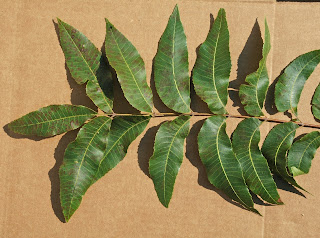Back in early October, I was collecting nuts samples from our breeding plots when I took a few minutes to photograph downy spot, a minor pecan disease not often seen in well tended groves. This disease popped up in the breeding plot for two reasons. First, we don't apply fungicides to the breeding block to enable us to check for scab resistance. And second, 15 inches of rain over 4 weeks in mid-summer provided great conditions for disease spread.
By the time I photographed downy spot, the disease was in in advanced stages of development. Looking at the underside of a leaflet with the sun streaming from above, it is easy to see the irregular shaped lesions of downy spot. Each lesion appears yellow with dark patches at the margins and within the lesion (photo at right).
Viewed from the upper side of the leaf, downy spot appears as faint brown patches on the foliage (photo at left). An extensive downy spot infection causes early defoliation in the fall. Prior to early defoliation, this disease can reduce photosynthesis by up to 40%.
Downy spot is caused by the fungus, Mycosphaerella caryigena, which overwinters on fallen leaves from the previous season.
Downy spot gets its name because the disease first appears on the underside of leaves as a faint light green spot that turns white and "downy" as the fungus begins to sporulate. As the season progresses, downy spot lesions grow upward through the leaf blade until they reach the upper leaf surface. At this point, spore production has ceased and the downy spot lesions appear brown in color, especially on the underside of leaves (photo at right).
Downy spot is usually controlled when fungicides are applied for the control of pecan scab.


